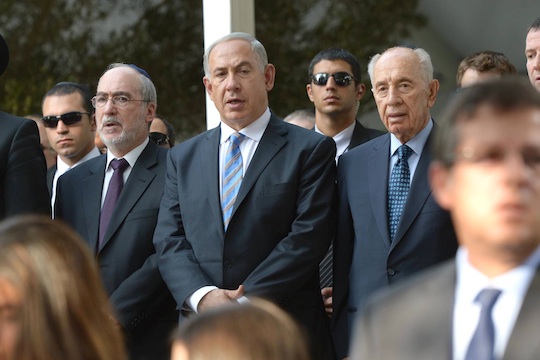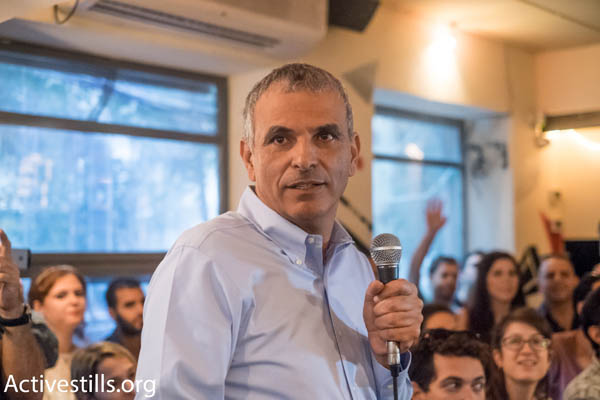Without the Arab citizens there is no ‘left-wing bloc’ in Israeli politics. The only problem? The inclusion of Arabs was what led the Right to violently bring down the Left in the first place.
By Lev Grinberg
Since the assassination of Yitzhak Rabin, there have been no political blocs in Israel. No Left and no Right — only survival combinations. Therefore, all the talk of the “size of blocs” only distorts the depressing reality in Israeli politics, wherein the real issues are barely discussed.

The reason there have been no blocs since 1995 is simple: the assassination of Yitzhak Rabin was an attack on the very existence of a “left-wing bloc” consisting of Labor, Meretz and the Arab parties. The message was well understood, and no such cooperation exists any longer. Since the assassination, all the Jewish parties have had little problem sitting alongside one another in the coalition: Meretz sat with the National Religious Party in 1999; and the other coalitions included Yesh Atid, Kadima and Labor sitting with Likud, Liberman and the Jewish Home. Labor not only sat alongside Likud in Ariel Sharon’s government (in 2001 and in 2004), but also under Netanyahu’s in 2009. The truth is that Livni and Herzog sat in Netanyahu’s government until they were kicked out, Herzog by Ehud Barak, and Livni by Netanyahu himself. Instead of an ideological split between the Right and the Left, the main gaps today are between the parties that are willing to sit in any government.
The “right and left” blocs are the ones that, in the past, allowed for the biggest changes in Israeli politics, such as Likud’s ascension to power in 1977, or Labor’s victory in 1992. Likud and Labor continue to speak of blocs today in order to preserve their status as a “cartel” whose leaders are the only candidates to become prime minister. This, despite the fact that the two have been downgraded to “third party” status in recent years (in 2006, when Likud received 12 Knesset seats, and in 2009 and 2013 when Labor received 13 and 15, respectively).
In the absence of ideological blocs, no major changes should be expected. Rather, we should expect new “survival combinations.” Instead of changes in foreign or domestic policy, the new government will present a new facade for external consumption. Significant changes take place only in the wake of serious ideological shifts that define a shared political identity of a bloc. In 1977, the shift was facilitated by the ideological shift of the National Religious party, which was transformed from an historic ally of the pre-Labor Mapai party to a supporter of the Likud’s “entire Land of Israel” ideology. Likud actually became more moderate and was ready to return the Sinai Peninsula to Egypt and grant autonomy to the Palestinians. In 1992 it was Rabin who underwent a radical ideological turnabout toward negotiations with the PLO, and showed readiness to form a political bloc with Meretz, Hadash and the Arab Democratic Party. In both cases, establishing political blocs led to major changes, which eventually enabled the signing of peace agreements and fundamental changes to Israel’s economic policies.
So why did Rabin’s assassination terminate the “left and right” political blocs? The three bullets that killed Rabin immediately closed the political space of Israel’s Arab citizens. Rabin brought them in, and his assassination shoved them out. Without the Arab citizens there is no “left-wing bloc,” and no need for its opposing “right wing bloc.” The public lynching of Rabin that preceded his actual killing targeted him for relying on Arab votes to advance his policies. His detractors claimed that without the support of a Jewish majority, he wouldn’t have a mandate to concede parts of Greater Israel. Rabin rejected those criticisms as racism. Indeed, in order to legitimize his murder, Rabin’s detractors dressed him in a keffiyeh. In other words, Rabin’s murder was a racist attack.
Since then, the racist discourse has permeated the entire Israeli political arena, not only among the “right,” but also in the so-called “left” and “center.” All of them have adopted the worldview that impossible to make concessions over the Land of Israel by relying on the political support of the “Arabs.” However, if we automatically subtract 10 percent of Knesset members from potential coalitions, we shouldn’t be surprised when, time after time, the Likud is the only party that can select which partners will join it in the government.
Yes to the ultra-Orthodox, no to the Arabs
When Israelis head to the polls on March 17, no one will be talking about a political upheaval, but rather a complication of the existing reality. The analysts will spend their time speculating over the different combinations that would make political survival possible. The question is not whether Likud will have enough power to build a “right-wing” coalition with Jewish Home, Yisrael Beiteinu, the ultra-Orthodox parties and “Kulanu” (the new party Headed by former Likud Minister Kahlon), simply because no such bloc exists. The question will be whether the ultra-Orthodox parties, Liberman and Kulanu will prefer Netanyahu over Herzog. Only then will it become clear that the problem lies not in the Right or the Left, but in the “center,” between Lapid’s Yesh Atid and the ultra-Orthodox.
The tension between the Ashkenazi seculars and the ultra-Orthodox parties has divided Israeli politics since the end of the “left-right’ bloc. It brought down Barak’s government in 2000 within a year, and led Likud to kick out the ultra-Orthodox parties whenever they cooperated with the Lapid family (both the father in 2003, and the son, in 2013). Will Herzog be able to get over the secular desire to establish a “center-left” coalition with the ultra-Orthodox parties and the ultra-seculars Meretz and Yesh Atid?
If and when the coalition options of “right” and “center-left” fall, the option of a “national unity government” between Likud and Labor, headed by either Netanyahu or Herzog (or a rotation of both) will be established either in its Ashkenazi-secular version (with Yesh Atid, Liberman and Kulanu) or in its “social” version — with the ultra-Orthodox parties and Kulanu. Kahlon, it seems, will be a deciding factor after the next elections, and will likely be included in any coalition.
What is certain is that “Rabin’s coalition” — with Labor, Meretz, the ultra-Orthodox and the Joint Arab List — will not come into existence. It could have been a real upheaval: social, economic and political. But in order for this to happen, a Knesset majority is not enough. We need leadership and a vision, both of which are severely lacking in these elections.
Professor Lev Grinberg teaches at Ben Gurion University, is a specialist in Israeli politics, economy and society. He also publishes his analysis of public issues on several languages and varied venues. His last books are Politics and Violence in Israel/Palestine – Between Democracy and Military Rule in Israel/Palestine (Routledge, 2010) and Mo(ve)ments of Resistance – Politics, Economy and Society in Israel/Palestine, 1931-2013 (Academic Studies Press, 2013).
This article was first published on +972′s Hebrew-language sister site, Local Call. Read it in Hebrew here.

